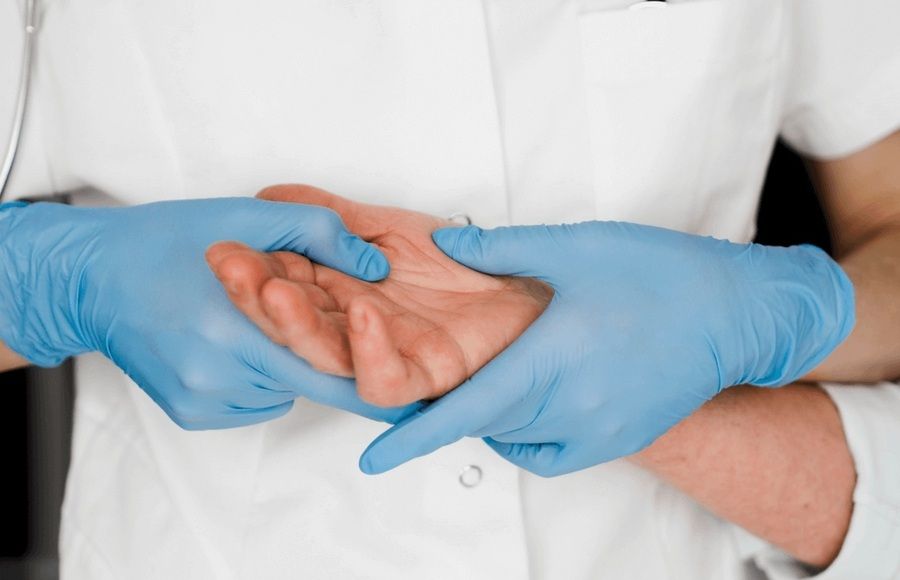Understanding the Top 8 Types of Hand & Wrist Surgeries
If hand or wrist pain is affecting how you work, drive, or care for yourself, you know how disruptive it can be. This article breaks down the most common surgical procedures that the best orthopedic surgeon in San Francisco uses to treat hand and wrist injuries, so you can better understand your options and what recovery might involve.

Contents
Hand and wrist pain can make even simple tasks feel frustrating. Things like opening a jar, typing an email, or gripping the steering wheel can suddenly feel difficult or even impossible. And since the wrist and knuckle joints in your hand are especially prone to overuse injuries, pain often doesn’t improve with rest or physical therapy. This is why surgery may offer the best long-term relief. Disorders like carpal tunnel syndrome alone affect up to 6% of adults in the U.S., often requiring surgical treatment when symptoms become severe.
Read on to get a breakdown of eight common hand and wrist surgeries, explaining what each one treats, why it’s done, what recovery typically looks like, and where to find the best orthopedic surgeon in San Francisco to get you back to a pain-free lifestyle.
Top Eight Hand and Wrist Surgeries Offered by the Best Orthopedic Surgeon in San Francisco
Your hands and wrists are made up of complex networks of bones, tendons, nerves, and joints, all working together to support movement, grip strength, and fine motor skills. When injury, overuse, or structural issues interfere with these functions, an orthopedic hand surgeon may recommend minimally invasive techniques or open surgery, based on the diagnosis and imaging results, to restore function and provide pain relief.
1. Carpal Tunnel Release Surgery
The median nerve runs through a narrow space in your wrist called the carpal tunnel, and when it’s compressed, it can cause symptoms like numbness, tingling, or weakness in your hand and fingers. During this surgery, an orthopedic doctor cuts the transverse carpal ligament, which is the tissue pressing on the nerve, to relieve pressure and create more space.
It’s usually recommended when symptoms persist despite other treatments, such as splints or physical therapy. Recovery time depends on your overall health and the severity of the condition, but most people can return to light activities, such as typing or driving, within a few weeks.
2. Bony Mallet Finger Repair
An injury that makes it impossible to straighten the tip of your finger happens when the tendon that straightens the finger is damaged or when a small piece of bone is pulled off where the tendon attaches; this is a type of injury called a bony avulsion. In many cases, the finger can be treated with a splint that holds it in a straight position while the tendon or bone heals. However, if the break is severe or the joint is unstable, surgery may be needed to place small pins and help the bone heal in the right position.
3. De Quervain’s Tendon Release
This surgery is used to treat pain and swelling near the base of the thumb, caused by inflammation in the tendon sheath. This condition, known as De Quervain’s tenosynovitis, can cause pain when gripping, twisting, or lifting objects. When treatments like splinting, rest, or steroid injections don’t provide lasting relief, surgery is typically the next step.
During the procedure, the surgeon carefully opens the tight sheath to give the tendons more room to move without irritation. After surgery, some patients may require physical or occupational therapy to rebuild thumb strength, reduce stiffness, and regain full range of motion.
4. Ganglion Cyst Excision Surgery
Ganglion cyst excision surgery is done to remove a fluid-filled lump that often forms on the wrist or hand. These cysts can vary in size and may grow larger with activity or repetitive movement. While some ganglion cysts go away on their own, others cause pain, press on nearby nerves, or make it hard to move the joint. Surgery is usually recommended if the cyst keeps coming back or causes ongoing problems.
The procedure involves cutting out the cyst and part of the tissue it’s attached to, which helps lower the chance of it returning. However, even with successful surgery, there’s still a small risk that the cyst could come back over time.
5. Metacarpal Fracture Repair
The metacarpals are the long bones in your hand that connect your fingers to your wrist, and when one of them breaks, it can affect how your hand moves and grips. This is often caused by falls, sports injuries, or punching something hard. Surgery is done to realign and stabilize the bone; sometimes using small pins, screws, or metal plates, depending on how severe the break is and where it’s located.
After surgery, it’s important to start hand therapy or gentle movement as soon as your doctor allows. Early rehab helps prevent stiffness, reduce swelling, and restore strength so you can return to normal hand function.
6. Percutaneous Scaphoid Repair
Fractures of the scaphoid, one of the small bones in the wrist, can be tricky to heal because it has a limited blood supply. In some cases, the fracture doesn’t heal well with a cast alone, making surgery the best option. During the procedure, small incisions and live imaging are used to guide a screw into the bone, holding it together while it heals. This minimally invasive approach causes less damage to surrounding tissue and can speed up recovery time compared to open surgery. Fixing the fracture early helps prevent long-term problems like arthritis, chronic pain, or wrist instability.
7. Trigger Finger Release Surgery
Trigger finger is a condition that causes a finger to get stuck in a bent position or feel painful when straightened. This happens when the tendon that moves the finger can’t glide smoothly through its protective sheath, often due to swelling or thickening in the area.
During trigger finger release surgery, a small incision is made in the palm and the tight part of the tendon sheath, allowing the tendon to move freely again. The procedure is usually quick and done under local anesthesia, meaning you stay awake but won’t feel pain in your hand. Many patients notice that their finger moves more easily just a few days after surgery, although it can take a few weeks for the swelling to subside and full strength to return.
8. Wrist Distal Radius Fracture Repair
A break near the end of the radius, the larger of the two bones in your forearm, is common when someone falls and lands on an outstretched hand. If the broken bone is out of place or unstable, surgery is often necessary to realign it properly and stabilize it while it heals. This surgery sometimes involves the use of a metal plate and screws to secure the bone in place. After surgery, physical therapy is an important part of recovery. It helps reduce stiffness, improve movement, and rebuild strength so you can return to your normal activities.
Finding the Best Orthopedic Surgeon in San Francisco for Hand and Wrist Surgery
At our practice, we know that hand and wrist injuries don’t just affect your body; they interrupt your daily rhythm. That’s why Dr. James Chen takes a thoughtful, whole-patient approach to orthopedic care, combining advanced surgical skill with the personal attention you deserve.
As a fellowship-trained surgeon with specialized expertise in hand and wrist procedures, Dr. Chen offers both minimally invasive and open surgical techniques tailored to your specific injury. We prioritize conservative treatments first, but when surgery is necessary, you’ll have access to state-of-the-art diagnostic tools, like live fluoroscopy and ultrasound, right here in our office.
Ready to ensure you return to full strength and mobility after hand or wrist surgery with the best orthopedic surgeon in San Francisco?










